Do you know what boyos and bulemas are? You may have even eaten one without realizing it, but more on that later.
Some time ago, I wrote a post about the Jewish history of bourekas, mentioning in it that they were one of three Sephardic pastries commonly referred to as “The Three B’s.” Boyos and bulemas are the other two. Since I didn’t have the space in my previous post to go any further than bourekas alone, I want to use this post to explain the other two thirds of the famous triumverate.
Before I go any further, however, an important note. As I wrote in the bourekas post, terminology and shapes are notoriously confusing among these foods, with different names often applied to the same pastry or the same name applied to different ones. So if, as you read this post, you see something I wrote about boyos or bulemas and it doesn’t match what you know from your nona, or the pastry that you grew up with, please read on. I will do my best to get to all of the variations that I have come across.
The information I present here I’ve compiled by examining a number of Sephardic cookbooks, scholarly texts on Jewish food, websites from home cooks of Sephardic descent, and Facebook groups. That being said, if I miss something, please leave a comment to correct or update me!
Bollos, Boyos, Boyikos, etc.
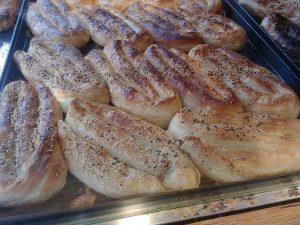
Once the bread got stale after a few days, it would be soaked in water or milk, flavored with a bit of spices and/or cheese, and then fried in small portions to become a light and flavorful snack.(1)Gil Marks Encyclopedia of Jewish Food The full name was bollos de pan, with bollos in Spanish referencing balls or small buns, and pan meaning bread. The spelling changed (and perhaps, slightly, the pronunciation) in Turkey to boyos.
In Ottoman Palestine, in Jerusalem of the 1880s, we hear of boyos de pan being made in exactly this way, with cheese and pepper added in with the soaked stale bread. Those who made it were clearly identified as of Sephardic descent.(2)John Cooper Eat and Be Satisfied
In time, however, this simple and frugal dish became beloved to the point that a slightly “higher class” version was created. People started making boyos out of a freshly made dough. For example, Lady Judith Montefiore, in 1846 London, published The Jewish Manual, the first Jewish cookbook in English. Her background, and thus the recipes in her book, mixed Sephardic and Ashkenazi heritages, and all were designed for a community of upper and upper-middle class Jews. In the book, she includes the following recipe:
Take one pint of milk, stir in as much flour as will bring it to the consistency of hasty pudding; boil it till it becomes thick, let it cool, and beat it up with ten eggs; when smooth, take a spoonful at a time, and drop it into a frying-pan, in which there is a good quantity of boiling clarified butter, fry of a light brown, and serve with clarified sugar, flavored with lemon essence.
Sounds very similar to the boyos de pan that we’ve been speaking about, though made from a fresh batter, rather than refreshed stale bread. And even more peculiar is the name of the recipe; she refers to it as Prenesas, a name we don’t find attested elsewhere. Gil Marks says this dish was simply “another type of boyo.” The names Montefiore used in her book are notorious for peculiar English spellings, and other oddities. The only potential meaning or source I can find for the word prenesas is from Portuguese (part of the core of Sephardic heritage), and it apparently means “presses,” if Google Translate is to be trusted. Perhaps the name she gave it had something to do with the process by which her boyos were made, something we see in Turkish examples.
One of the main cities in Turkey where Sephardic Jews settled was Izmir, and today, one of the unique pastries of the city is boyoz (with again, a slightly different spelling). It is recognized by all as being a legacy of the Sephardic Jews there, though now it is made by Izmiri non-Jewish bakers too. Boyoz (what you see in the main picture at the start of this post) are also made from fresh dough, a puff pastry enriched with butter, stretched ultra thin, folded and rolled up, then cut into small balls. Those balls are then pressed gently into rounds and baked in the oven. This video shows boyoz being made in Izmir today.
Beyond that, though the classic Turkish examples are purely dough and butter, there are other examples that are filled and/or topped with cheese. Both the type of dough, and the fillings, seem to turn this modern Turkish version into a more sophisticated pastry that has transcended its humble roots.
Allegedly, the boyos of Izmir were only made at home by Jews there until the sometime during the first half of the 20th century, when they began selling it commercially. So it is highly plausible to think that the ones that home bakers made were much closer to the original boyos de pan. In fact, the Turkish Jewish cookbook Sefarad Yemekleri offers up that exact classic version, using a diminutive form of the name, boyikos de pan. Stale bread is mixed in it with eggs, feta and manchego cheeses, sunflower oil and salt before small balls of the mixture are fried up.
Bulemas, Rodanchas, and Boyos (again)
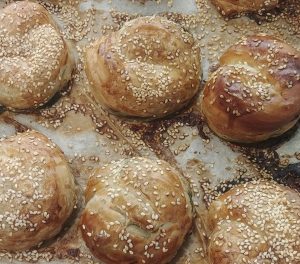
Thus, bulemas are a clear cousin to bourekas, more so than the early boyos were. In fact, the popular large style borek sold in Israel today and referred to as “Turkish Bourekas” are actually straight up kol böreği. This underscores the relationship. Furthermore, the classic shape for a spinach boureka in Israel today is a spiral, making it appear very similar to a classic bulema more than a boureka (or fila). And remember that spinach was one of the very popular fillings for bulemas in the first place.
While nearly everyone agrees what a bulema is, many call it by other names. One common name among the Jews from the island of Rhodes is rodanchas, coming from the same word for “rose” that the island’s name derives from.
Even more confusing, however, is that also on Rhodes, the dish was commonly referred to as… boyos! I have not been able to explain this with certainty, but here is my speculation on how this all went down. Turkish Jews were making the classic, simple boyos de pan out of old bread. Somewhere along the way, some started making the more sophisticated version using fresh thin dough and fillings. The process and final product were fairly similar to bulemas, just in an uncoiled shape. (In fact, some of the versions one encounters today can only be differentiated by the shape alone.(3)Joyce Goldstein Sephardic Flavors) With the Rhodes community’s close connections to the Sephardic community inside Turkey, it makes sense to think that these two pastries might easily have been associated with each other. If the original boyos themselves were not particularly popular in Rhodes, it might explain how the (shorter and simpler) name then was reapplied to the now-similar bulemas.
Bottom line, however, is that today, boyos might mean the original version made of old bread, an updated version in which the dough is freshly made for it, a more advanced puff pastry that is filled or not, or even that same filled pastry once coiled up. That latter shape, in turn, might be called boyo, or bulema, or rodancha. And no matter which shape or name one uses, these boyos and bulemas can join bourekas and huevos haminados as key components of the Shabbat morning desayuno.
And thankfully, you don’t need to be of Sephardic descent to enjoy boyos and bulemas, any more than you do to chow down on some delicious bourekas. As we say in Hebrew, B’teavon (bon appetit)!

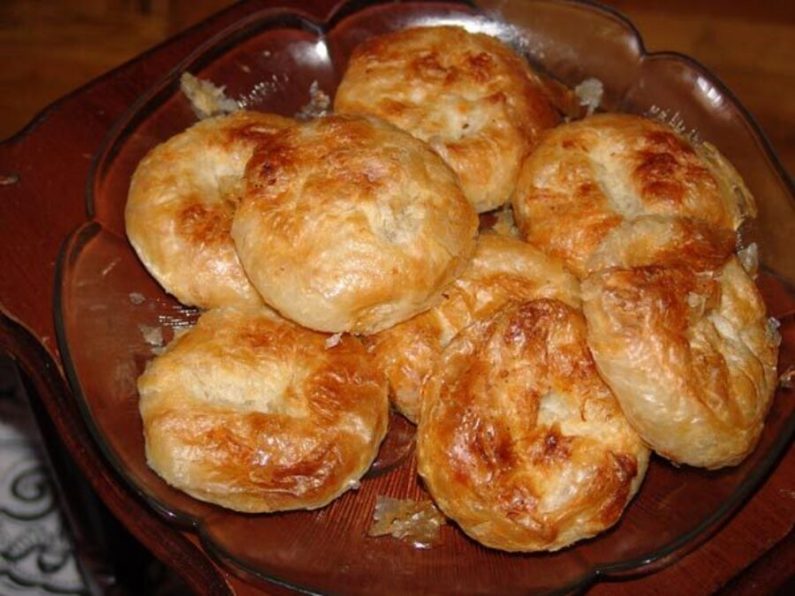

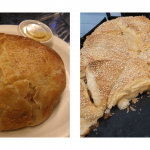
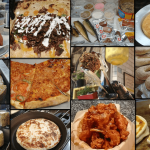


moreno
how about some recipes?
FunJoel
Thanks for your response!
I don’t really do a lot of recipes here — not a cooking blog, but a food history one. I might be able to dig up one or two, but a Google search might be better at it! But if you’re having trouble, let me know and I’ll see what I can find.